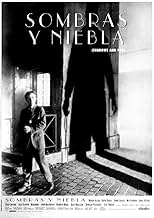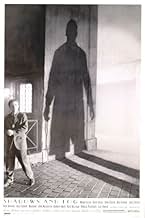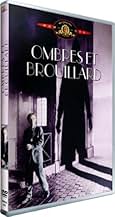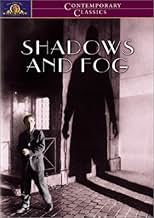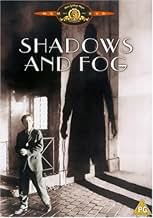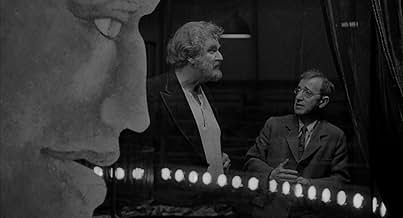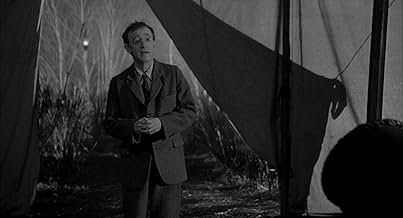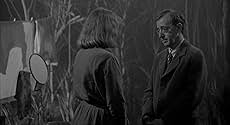IMDb रेटिंग
6.7/10
19 हज़ार
आपकी रेटिंग
एक गला घोट कर हत्या करने वाला सीरियल किलर फरार है एक लेखाकार उस हत्यारे को तलाश रहे निगरानी समूह की तलाश में शहर में घूमता है.एक गला घोट कर हत्या करने वाला सीरियल किलर फरार है एक लेखाकार उस हत्यारे को तलाश रहे निगरानी समूह की तलाश में शहर में घूमता है.एक गला घोट कर हत्या करने वाला सीरियल किलर फरार है एक लेखाकार उस हत्यारे को तलाश रहे निगरानी समूह की तलाश में शहर में घूमता है.
- पुरस्कार
- 1 जीत और कुल 2 नामांकन
Daniel von Bargen
- Vigilante
- (as Daniel Von Bargen)
फ़ीचर्ड समीक्षाएं
"Shadows and Fog" is Woody Allen's tribute to German Expressionism, and it's very interesting, often funny, and at times downright strange. He gives no indication of the setting or time, and as is often true with Allen, there's a serious undertone. His nebishy character, Kleinman, is woken up in the middle of the night in his home for reasons having to do with a serial killer at large. Poor Kleinman doesn't know exactly what he has to do with anything, but as he puts it, everything seems to know what he's supposed to be doing but him. Across town, Mia Farrow is the circus performer Irmy, who finds out her boyfriend (John Malkovich) is cheating on her, so she leaves him. She winds up in a brothel with some real characters played by Lily Tomlin, Kathy Bates, and Jodie Foster. A client (John Cusack) declares himself in love with Mia and offers her money to sleep with him. When it gets up to $700, she accepts. Later she meets Kleinman and sends him to the church to donate all but $50. The priest is impressed, and the police cross Kleinman's name off the list of suspects. Then they meet a beggar, and she sends Kleinman back for half the money. Kleinman's name goes back on the list of suspects.
Yes, it's an odd but fascinating film. The atmosphere is bizarre, very German - dark, bleak, and foggy, with a scary serial killer out of "M." Big stars float in and out of the film, like Madonna, some with tiny roles. The funniest scene is when Kleinman tries to hide out at his ex-girlfriend's (Julie Kavner) who calls him every name in the book and then tries to turn him in.
Kleinman is an innocent man caught in confusing circumstances and times, not sure which side he should be on - there are two factions trying to catch this killer, and both attempt to recruit him - and all the poor guy wants is a promotion at his job. Though his reactions are often amusing, imagine being awoken by the police in the middle of the night and having no idea what it's about. It's happened, though, as it happens in the film. As Kleinman wanders the streets, unsure of where he's going, we can relate.
Yes, it's an odd but fascinating film. The atmosphere is bizarre, very German - dark, bleak, and foggy, with a scary serial killer out of "M." Big stars float in and out of the film, like Madonna, some with tiny roles. The funniest scene is when Kleinman tries to hide out at his ex-girlfriend's (Julie Kavner) who calls him every name in the book and then tries to turn him in.
Kleinman is an innocent man caught in confusing circumstances and times, not sure which side he should be on - there are two factions trying to catch this killer, and both attempt to recruit him - and all the poor guy wants is a promotion at his job. Though his reactions are often amusing, imagine being awoken by the police in the middle of the night and having no idea what it's about. It's happened, though, as it happens in the film. As Kleinman wanders the streets, unsure of where he's going, we can relate.
After completing Shadows and Fog, I found myself once again dismayed by the common claim that Woody Allen makes the same type of film over and over again. In reality, Woody has always been open to trying new and untested things both with his narrative structure and his filmmaking style. Shadows and Fog is another perfect example of Woody's penchant for diverse filmmaking. The 1991 film was Woody Allen's gentle homage to German Expressionism. Shadows and Fog pairs Woody Allen and Mia Farrow in a shadowy town that hides from a strangler that is on the loose. As is the usual Woody Allen film, Shadows and Fog is as wonderfully comedic as it is a thoughtful exercise in grappling with life's deepest questions.
Kleinman (Woody Allen) is a nebbish, nervous bookkeeper who has been pulled into a plot by a group of vigilantes to hunt for a strangler that has been terrorizing their area. A perpetually nervous individual, Kleinman wants nothing to do with a group of lawless men seeking out a murderer. Kleinman would rather stay locked in his apartment safely away from the murderer roaming the streets. To make matters worse, despite the fact that Kleinman has been roped into a group of vigilantes, information about his role in the group is being withheld from him. Sheepishly attempting to find his role within the vigilante group, all the while desperately trying to avoid putting himself in real danger, Kleinman encounters a woman in a traveling circus, Irmy (Mia Farrow) who is also attempting to find her way through life in a much more metaphorical sense. Kindred spirits, Kleinman and Irmy attempt to find a purpose for their lives, all the while trying to save them.
Shadows and Fog works perfectly as a nod to German Expressionism, with gorgeous imagery reminiscent of the greats of the genre such as Robert Wiene and Fritz Lang. Woody Allen's frequent use of black and white photography well into the 90's is a fearless maneuver that deserves uproarious applause. Woody is a filmmaker that uses a variety of film technique achieving artistic significance yet is hardly acknowledged for that. Certain aspects Woody is commonly acknowledged for are present in Shadows and Fog, for instance, it is exquisitely written and has a brilliant sound design. Shadows and Fog is another worthy mention in my crusade to prove that Woody Allen is not a filmmaker that has a clear section of "lower-tier" work, as he is often accused.
Kleinman (Woody Allen) is a nebbish, nervous bookkeeper who has been pulled into a plot by a group of vigilantes to hunt for a strangler that has been terrorizing their area. A perpetually nervous individual, Kleinman wants nothing to do with a group of lawless men seeking out a murderer. Kleinman would rather stay locked in his apartment safely away from the murderer roaming the streets. To make matters worse, despite the fact that Kleinman has been roped into a group of vigilantes, information about his role in the group is being withheld from him. Sheepishly attempting to find his role within the vigilante group, all the while desperately trying to avoid putting himself in real danger, Kleinman encounters a woman in a traveling circus, Irmy (Mia Farrow) who is also attempting to find her way through life in a much more metaphorical sense. Kindred spirits, Kleinman and Irmy attempt to find a purpose for their lives, all the while trying to save them.
Shadows and Fog works perfectly as a nod to German Expressionism, with gorgeous imagery reminiscent of the greats of the genre such as Robert Wiene and Fritz Lang. Woody Allen's frequent use of black and white photography well into the 90's is a fearless maneuver that deserves uproarious applause. Woody is a filmmaker that uses a variety of film technique achieving artistic significance yet is hardly acknowledged for that. Certain aspects Woody is commonly acknowledged for are present in Shadows and Fog, for instance, it is exquisitely written and has a brilliant sound design. Shadows and Fog is another worthy mention in my crusade to prove that Woody Allen is not a filmmaker that has a clear section of "lower-tier" work, as he is often accused.
Woody Allen's tribute to German expressionism is better than most critics would have you believe. Sure there is very little plot to speak of, it's more a series of vignettes and gags than a cohesive narrative. Sure, it ends rather abruptly, never solving the mystery, but none of this stopped my thorough enjoyment of this film.
As the title suggests the entire movie is designed in shadows and fog. Shot with beautiful black and white photography, Allen and cinematographer Carlo Di Palma create the look and feel of an unnamed East European city as seen in such films as M and Nosferatu. The lighting is set up so that in nearly every shot underlying shadows engulf the scene. In the exteriors a vicious fog rolls across the night sky obscuring most details. Through the fog bumbles Kleinman (Allen is his typical neurotic schmuck role) trying to find his role in a vigilante mob's plan to stop a serial killer roaming the streets. From dark night until dawn, Kleinman wanders from place to place meeting a wide variety of curious characters (played by an even more curious group of celebrities), the most endearing of which is a desperate sword swallower (Mia Farrow)who is has wandered into a brothel after fleeing her cheating boyfriend/clown (John Malcovich).
It is a little unsettling to watch Allen do his normal schtick while the characters around him are murdered, subjected to racial prejudice, beaten by the police and discuss such subjects as love, sex, and meaning. There is a subtext involving the plight of the Jews between the World Wars, foreshadowing the Nazis. Yet the gags remain as solid as any Woody Allen film. Amongst the seriousness of his subtext and the films he is paying homage to, Allen finds away to bring full bellied laughter. Though his quirky neurosis isn't as resolutely hilarious as it is in such films as Annie Hall, it is still enough to fill the film with mirth.
The film ends rather abruptly with Kleinman having never learned his role in the plan, nor the killer having been caught. Yet as the credits role we realize the mystery was not so much the reason behind the story as method in creating it.
As the title suggests the entire movie is designed in shadows and fog. Shot with beautiful black and white photography, Allen and cinematographer Carlo Di Palma create the look and feel of an unnamed East European city as seen in such films as M and Nosferatu. The lighting is set up so that in nearly every shot underlying shadows engulf the scene. In the exteriors a vicious fog rolls across the night sky obscuring most details. Through the fog bumbles Kleinman (Allen is his typical neurotic schmuck role) trying to find his role in a vigilante mob's plan to stop a serial killer roaming the streets. From dark night until dawn, Kleinman wanders from place to place meeting a wide variety of curious characters (played by an even more curious group of celebrities), the most endearing of which is a desperate sword swallower (Mia Farrow)who is has wandered into a brothel after fleeing her cheating boyfriend/clown (John Malcovich).
It is a little unsettling to watch Allen do his normal schtick while the characters around him are murdered, subjected to racial prejudice, beaten by the police and discuss such subjects as love, sex, and meaning. There is a subtext involving the plight of the Jews between the World Wars, foreshadowing the Nazis. Yet the gags remain as solid as any Woody Allen film. Amongst the seriousness of his subtext and the films he is paying homage to, Allen finds away to bring full bellied laughter. Though his quirky neurosis isn't as resolutely hilarious as it is in such films as Annie Hall, it is still enough to fill the film with mirth.
The film ends rather abruptly with Kleinman having never learned his role in the plan, nor the killer having been caught. Yet as the credits role we realize the mystery was not so much the reason behind the story as method in creating it.
On first viewing I wasn't crazy about Shadows and Fog, while the film looked fantastic and was well-directed the characters left me cold, the film didn't seem to know what tone it wanted and the story seemed meandering and dull. On re-watch however Shadows and Fog fared much better(as was with almost all the Allen films that didn't impress at first apart from Anything Else), it is nowhere near among Woody Allen's best and is around the lower middle of his filmography but I found it a good film and not among Allen's worst that it's often said to be. Visually, Shadows and Fog looks fantastic with brilliant black and white cinematography and Expressionistic images that are as striking as they are haunting. Allen's films are always well-made, but Shadows and Fog visually like Zelig is quite unique from a visual standpoint. The music is very eerie and fits the atmosphere perfectly, in fact if anything it adds to it. While it was confusing of what tone the film was trying to go with on first viewing, on re-watch it was much clearer and that criticism seems unfair now. The dialogue is both subtle and hilarious(love the brothel scenes) with sharp homages and insight in characteristic Woody Allen vein, but even more impressive was the murder-mystery element while a really chilling atmosphere is created, helped by the visuals and music. Allen's directing is as always adept and his performance, the most memorable, is a lot of fun. John Cusack does nervous and angsty very nicely and Jodie Foster and Kathy Bates are remarkably good in against-type roles. Shadows and Fog has imperfections, Mia Farrow for me overdoes it and comes across as shrill, John Malkovich deserved much more to do and is a little wasted and Madonna is rather out of place. The story does have its drawn out and aimless patches with an ending that felt convoluted and hurried, and the characters are not very interesting, a lot of them barely in the film. To conclude however, a good film but considering how well the best assets come off it could have been more than good. 7/10 Bethany Cox
Shadows and fog are everywhere in Shadows and Fog, one of Woody's most visually impressive pieces. One of his better chosen casts as well. (Check out William H Macy in a brief bit as a cop) Full of big ideas and classic comic bits, including all the great scenes at the brothel. Once again Woody's love of magic plays a part in the story. Some of his best zingers, too ( "They say a deranged killer has the strength of 10 men... I have the strength of a very small boy... with polio" -now that's funny.)Each character, main or brief, has a nice moment on screen, especially Julie Kavner in her best Marge Simpson voice playing Kleinman's bitter ex fiancee. She's hilarious. Loathe him or admire him: Allen always makes you think.
क्या आपको पता है
- ट्रिवियाThe film is an homage and tribute to German Expressionist cinema, particularly the works of German filmmakers F.W. Murnau, Georg Wilhelm Pabst and Fritz Lang.
- भाव
[last lines]
Kleinmann: What better way to - to spend the rest of my life than - than to help you with - with all those wonderful illusions of yours!
Roustabout: It's true. Everybody loves his illusions.
Magician: Loves them. They need them. Like they need the air.
- साउंडट्रैकThe Cannon Song from Little Threepenny Music
By Kurt Weill
Performed by Canadian Chamber Ensemble
Conducted by Raffi Armenian
Courtesy of CBC Records - Canadian Broadcasting Corporation
टॉप पसंद
रेटिंग देने के लिए साइन-इन करें और वैयक्तिकृत सुझावों के लिए वॉचलिस्ट करें
- How long is Shadows and Fog?Alexa द्वारा संचालित
विवरण
- रिलीज़ की तारीख़
- कंट्री ऑफ़ ओरिजिन
- भाषा
- इस रूप में भी जाना जाता है
- Sombras y niebla
- फ़िल्माने की जगहें
- उत्पादन कंपनियां
- IMDbPro पर और कंपनी क्रेडिट देखें
बॉक्स ऑफ़िस
- बजट
- $1,40,00,000(अनुमानित)
- US और कनाडा में सकल
- $27,35,731
- US और कनाडा में पहले सप्ताह में कुल कमाई
- $11,11,314
- 22 मार्च 1992
- दुनिया भर में सकल
- $27,35,731
- चलने की अवधि
- 1 घं 25 मि(85 min)
- रंग
- ध्वनि मिश्रण
- पक्ष अनुपात
- 1.85 : 1
इस पेज में योगदान दें
किसी बदलाव का सुझाव दें या अनुपलब्ध कॉन्टेंट जोड़ें



